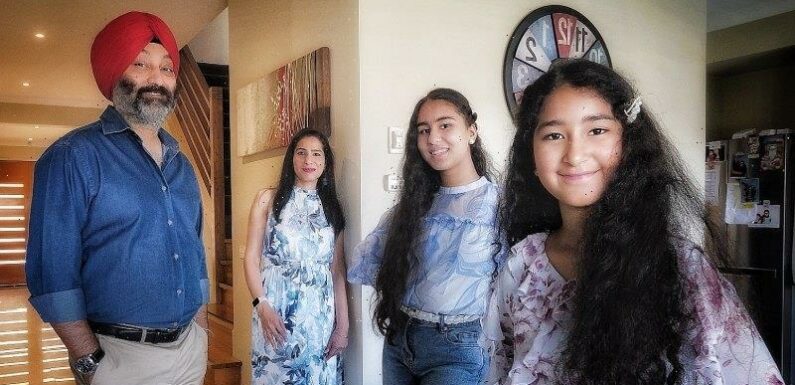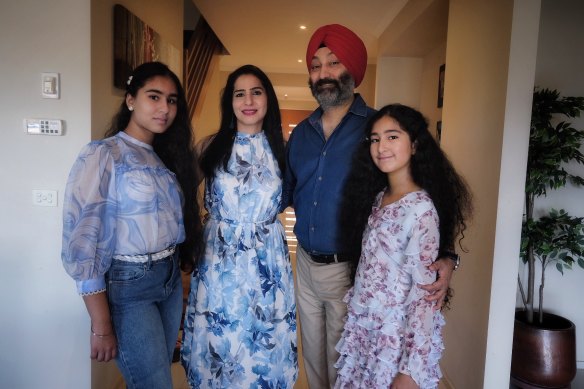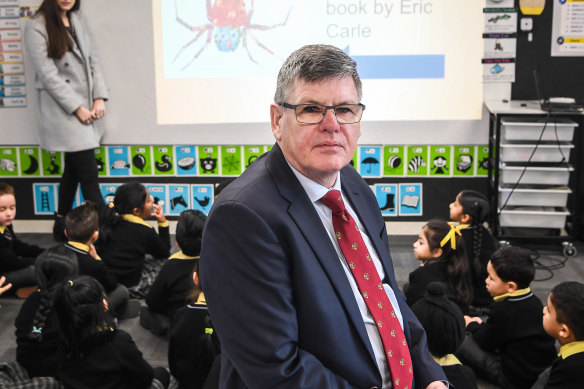
Aspirational migrant families have helped trigger a rise in enrolments in Victoria’s independent schools at the expense of their government and Catholic counterparts.
COVID-19 stalled a decade of rapid enrolment growth in Victorian schools, except in the independent sector, which accounted for an extraordinary 82 per cent of the growth between 2020 and 2022, according to census data.
Point Cook couple Paramdeep and Bhupinder Mata shifted their children Geet, 13, and Sehaj, 11, from the public system to a private school during the pandemic. Credit:Luis Ascui
Independent schools comprise Victoria’s smallest but fastest growing sector, with 15.64 per cent of students attending an independent school last year, compared with 63.5 per cent in the government system and 20.75 per cent in the Catholic system.
The growth in Melbourne’s outer suburbs is largely behind the enrolment rush. Data obtained exclusively by The Age shows a number of low-fee and faith-based schools are expanding rapidly in Melton, Casey, Whittlesea, Wyndham and Hume.
Schools such as Hume Anglican Grammar, Islamic College of Melbourne in Wyndham and Minaret College in Casey have grown by hundreds of students each year.
Growth is modest, however, in Melbourne’s inner and eastern suburbs, where many of the city’s most established high-fee private schools are at capacity.
Some inner urban municipalities even experienced a decline in enrolments in the independent sector, including Glen Eira, which had a 1.13 per cent decline. The city of Boroondara, which has thousands more independent school students than any other municipality, recorded a 1.57 per cent increase.
Bacchus Marsh Grammar was among the schools that experienced runaway growth during the pandemic, forcing it to recently open a second campus in Aintree, in the city of Melton. The school took in an extra 572 students between 2020 and 2022.
Principal Andrew Neal said population growth explained some of the school’s expansion, noting nearby state schools were also growing rapidly.
He said many of the school’s new students came from migrant families, and the school had become more multicultural as it grew.
Bacchus Marsh Grammar principal Andrew Neal said enrolments at his school soared during the pandemic.Credit:Justin McManus
“If you go back to 2015, it was basically an Anglo-Celtic school,” Neal said. “It’s a school now that still has a substantial number of children of European background, but there is a massive influx of students from South Asia.”
MySchool data reveals that between 2017 and 2022, the school’s proportion of students from non-English-speaking backgrounds grew from 7 per cent to 32 per cent.
Neal said many South Asian families had a preference for private schools.
“I think that what they are looking for in a school is a structured school, a well-disciplined school with a focus on academics, and they see that in the independent sector and in the selective [state] high schools,” Neal said.
Paramdeep Mata took her two children out of their local state school in Point Cook two years ago, enrolling them at Bacchus Marsh Grammar’s Aintree campus, despite the 40-minute commute each way.
Mata said the state school lacked a culture of academic discipline that she wanted for her children.
“If a child does their homework, they have the same treatment as a child who does not do their homework, so they [her children] would go, ‘Mum, why do I need to do it?’” Mata said.
“That’s how life is. You can’t just go back to work and say, ‘I’m sorry I have not done my assignment.’ So I think it’s a good thing to inculcate that in kids when they are young.”
McCrindle demographer Geoff Brailey said “aspirational” migrant communities were well represented among those moving to Melbourne’s sprawling fringe and outer suburbs.
“It’s growing in the primary [school] area. People are positioning for future years for their children to go to those independent schools,” he said.
Brailey said many families prioritised personalised education experiences and academic results, and often felt independent schools would be better resourced than government schools.
The Australian Curriculum, Assessment and Reporting Authority’s national report on schooling, published last month, revealed that in 2021, independent schools received on average $24,953 per student, compared with $20,940 per government school student.
Forty-nine per cent of independent school funding came from government grants, and 51 per cent from private sources, mainly fees.
Grattan Institute education program director Dr Jordana Hunter said the trend towards independent secondary schools was notable. She said governments needed to recognise the trend was drifting away from their schools.
“The fact that over 40 per cent of secondary school students are going to non-government schools really should give governments pause [for thought],” she said.
“Because the government option is basically free, and if parents are still choosing to send their children elsewhere, it’s important for government to question what they are not offering that makes other schools more attractive.”
Independent Schools Victoria chief executive Michelle Green said growth in enrolments in low-fee independent schools had been strong in new suburbs and on Melbourne’s urban fringe. In some cases, it filled gaps when new government schools had failed to catch up with population growth, she said.
“These schools are meeting the needs of young families who’ve been drawn to urban growth areas by more affordable housing,” she said.
Patrick Elligett sends an exclusive newsletter to subscribers each week. Sign up to receive his Note from the Editor.
Most Viewed in National
From our partners
Source: Read Full Article

